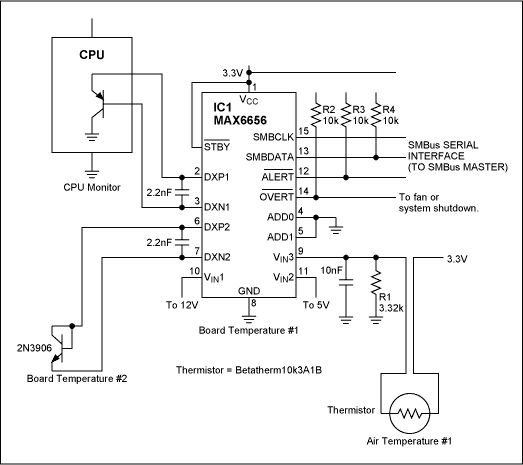The circuit in Figure 1 protects a system from overheaTIng by monitoring temperature in at least three locations using three different temperature measurement techniques. Thermal problems can be identified in three completely different environments; by measuring the temperature of a PCB, the die temperature of a CPU or other IC with a thermal sensing transistor, and chassis air. Monitoring PC board temperature helps to identify overheating of chips in the vicinity of the sensor. Monitoring the die temperature of a CPU, FPGA, or other high-power chip that has an on-chip thermal monitoring diode can very quickly detect dangerous thermal conditions before an expensive device is damaged by heat. Air temperature can indicate such conditions as a failed or blocked cooling fan.

Figure 1. In addition to monitoring the temperature of a CPU (or other IC with a thermal sensing diode) and a circuit board, this circuit also measures air temperature within the box. When any temperature exceeds a programmable limit, an ALERT can be sent to warn the system of an over-temperature condition.
Easily available temperature monitoring ICs allow accurate, automated measurement of board and remote thermal diode temperature, but do a poor job of measuring air temperature. They measure board temperature well, because they are in direct thermal contact with the board through their leads. But unless the air and board temperatures are the same, they can't directly sense air temperature. One way to sense air temperature is to use an NTC (negative temperature coefficient) thermistor with long leads. The long leads help to isolate the NTC element from the board temperature. Specialized air temperature probes with longer leads are available from thermistor manufacturers. To measure air temperature in this circuit, an NTC and a resistor are connected in series to form a voltage divider and the voltage across the series resistor is measured.
The circuit in Figure 1 lets you measure and monitor CPU, circuit board, and ambient temperature. IC1 is a temperature and voltage monitor that continuously captures the temperature of two external thermal sense transistors, its own temperature, its supply voltage, and three external voltages. All measured quantities are compared against programmable temperature and voltage limits; if a value falls outside its limits, the ALERT pin asserts.
IC1 measures its own die temperature, and therefore board temperature, with an accuracy of 1.5°C from 60°C to 100°C. Over the same temperature range, external ICs with thermal sense transistors are monitored with 1.0°C accuracy. The external ICs might be two CPUs, a CPU and an FPGA, or some other combination of remote devices. One of the remote sense transistors can even be a discrete transistor measuring board temperature some distance from IC1. Use a 2.2nF capacitor across IC1's DXP and DXN pins to filter external noise that might disrupt the temperature measurement/conversion process.
The relationship between a thermistor's resistance and its temperature is very nonlinear, but over a limited temperature range can be moderately linear when used with the right series resistor. The circuit in Figure 1 has been optimized for good linearity with thermistor temperatures in the range of about 20°C to about 70°C; less than 0.8°C linearity error over the range of interest. The average slope in this range is 29.35mV/°C, and voltage monitor input VIN3 has an LSB value of 11.9mV. This results in an LSB weighting of 0.405°C/LSB. At 20°C, the voltage on R1 is nominally 693mV, which corresponds to a measured code of 46 (decimal).
Note that the accuracy of the ambient temperature measurement would normally depend on the thermistor/resistor combination being connected to an accurate reference voltage. To minimize cost in this circuit, however, the thermistor and R1 are simply connected to IC1's supply voltage. This could cause an error on the order of a few degrees, but fortunately IC1 monitors its own supply voltage, allowing you to correct for any supply voltage errors in software. If the supply voltage is high by 3%, for example, the measured voltage at a given temperature will be 3% high. At 65°C, the output voltage is ideally 2.03V. If the supply voltage is 3% high, the measured temperature will be about 61mV high (approximately 2°C error).
Communication is via the SMBus. Thermal and voltage fault limits can be set via the SMBus. When any temperature (or voltage) is outside of the correct range, an ALERT is asserted. An additional limit can be set for each of the local and remote transistor temperatures to generate an OVERT (Over-temperature) output that may be used to activate a cooling fan or shut the system down.